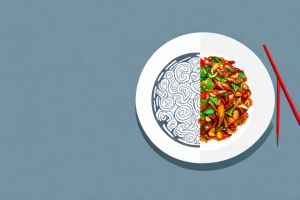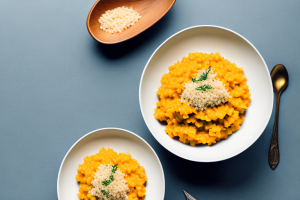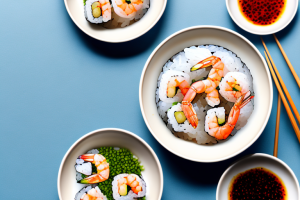How to cook quinoa rice with Mediterranean vegetables
8 min read
A bowl of quinoa rice with mediterranean vegetables
Are you looking for a delicious and healthy dish that’s easy to prepare and full of flavor? Look no further than quinoa rice with Mediterranean vegetables! This recipe combines the protein-packed, nutty flavor of quinoa rice with the fresh, bright taste of Mediterranean veggies like zucchini, tomatoes, and bell peppers. Not only is this dish incredibly tasty, but it’s also packed with vitamins, minerals, and antioxidants that benefit your overall health.
The health benefits of quinoa rice and Mediterranean vegetables
Quinoa rice is a superfood that’s high in protein, fiber, and micronutrients like magnesium and potassium. It’s also gluten-free, making it a great option for people with gluten sensitivities or celiac disease. Mediterranean vegetables like tomatoes, bell peppers, and zucchini are low in calories but high in vitamins and fiber, making them an excellent addition to any diet. They’re also full of antioxidants that protect your cells from damage and reduce the risk of chronic diseases like cancer and heart disease.
In addition to their individual health benefits, quinoa rice and Mediterranean vegetables are also a great combination for a balanced meal. The high protein content of quinoa rice helps to keep you feeling full and satisfied, while the fiber in the vegetables aids in digestion and promotes healthy bowel movements. This combination also provides a variety of essential nutrients that your body needs to function properly, including vitamins, minerals, and antioxidants.
An overview of the ingredients needed for this recipe
To make quinoa rice with Mediterranean vegetables, you’ll need:
- 1 cup quinoa rice
- 2 cups water or vegetable broth
- 1 zucchini, julienned
- 1 red bell pepper, julienned
- 1 yellow bell pepper, julienned
- 1 cup cherry tomatoes, halved
- 2 cloves garlic, minced
- 1/4 cup fresh parsley, chopped
- 3 tablespoons olive oil
- 1 tablespoon balsamic vinegar
- 1 teaspoon honey
- Salt and pepper to taste
This recipe is not only delicious, but it’s also packed with nutrients. Quinoa rice is a great source of protein, fiber, and essential amino acids. The Mediterranean vegetables in this recipe are also loaded with vitamins and minerals, such as vitamin C, vitamin A, and potassium. Additionally, the olive oil used in this recipe is a healthy fat that can help reduce inflammation and improve heart health. So not only will this dish satisfy your taste buds, but it will also nourish your body.
Tips for selecting the best quinoa rice and vegetables
When selecting quinoa rice, choose a high-quality, organic brand to ensure that it’s free from pesticides and other harmful chemicals. Look for crisp, brightly colored vegetables when selecting your Mediterranean veggies. Choose vegetables that are firm to the touch and have no signs of decay or damage. If possible, select seasonal vegetables that are at the peak of freshness.
It’s also important to consider the origin of the quinoa rice and vegetables. Look for products that are locally sourced or have a transparent supply chain to ensure that they are ethically and sustainably produced. By choosing products that are both high-quality and responsibly sourced, you can enjoy a delicious and nutritious meal while supporting environmentally-friendly practices.
Preparing and cooking quinoa rice
To prepare quinoa rice, rinse it thoroughly in a fine mesh strainer to remove any bitterness. In a medium-sized pot, combine 1 cup of quinoa rice and 2 cups of water or vegetable broth. Bring to a boil, then reduce heat and simmer for 15-20 minutes, or until all the liquid has been absorbed and the rice is tender. Fluff with a fork and set aside.
Quinoa rice is a versatile ingredient that can be used in a variety of dishes. It can be served as a side dish, added to salads, or used as a base for a grain bowl. It is also a great alternative to traditional rice for those who are gluten-free or looking to add more protein to their diet.
When storing cooked quinoa rice, it is important to keep it in an airtight container in the refrigerator. It will last for up to 5 days and can be reheated in the microwave or on the stovetop with a little bit of water or broth to prevent it from drying out.
How to julienne Mediterranean vegetables
To julienne vegetables like zucchini and bell peppers, first cut off the ends and slice them in half lengthwise. Then, cut each half into thin, uniform strips that are approximately 2-3 inches in length.
For eggplant, it’s best to remove the skin before julienning. Cut off the top and bottom of the eggplant, then slice it in half lengthwise. Lay each half flat on the cutting board and slice it into thin, uniform strips. To prevent the eggplant from turning brown, soak the strips in cold water with a splash of lemon juice for 10-15 minutes before using.
Combining the cooked quinoa rice with the vegetables
To combine the quinoa rice and vegetables, heat 2 tablespoons of olive oil in a large pan over medium heat. Add the minced garlic and sauté for 1-2 minutes, or until fragrant. Add the julienned vegetables and continue to cook for 5-7 minutes, or until they are tender but still slightly crisp. Add the cooked quinoa rice and stir to combine.
For an extra burst of flavor, you can also add a tablespoon of soy sauce or tamari to the pan while cooking the vegetables. This will give the dish a savory, umami taste that pairs perfectly with the nutty flavor of the quinoa rice. Additionally, if you prefer a bit of heat, you can add a pinch of red pepper flakes or a diced jalapeño pepper to the pan with the garlic.
Adding seasonings and herbs to enhance flavor
To enhance the flavor of your quinoa rice with Mediterranean vegetables, add 1/4 cup of fresh parsley, chopped, as well as salt and pepper to taste. Stir to combine and continue to cook for another 1-2 minutes, or until everything is heated through.
Another great herb to add to this dish is fresh basil. Simply chop up a handful of basil leaves and add them to the quinoa rice mixture before cooking. The basil will add a fresh, aromatic flavor that pairs perfectly with the Mediterranean vegetables.
If you want to add a bit of heat to your quinoa rice, try adding a pinch of red pepper flakes. This will give the dish a subtle kick without overpowering the other flavors. Just be sure to add the red pepper flakes sparingly, as they can quickly become too spicy if you add too much.
A step-by-step guide on making a delicious dressing
To make the dressing for your quinoa rice with Mediterranean vegetables, combine 1 tablespoon of balsamic vinegar, 1 tablespoon of honey, and 1 tablespoon of olive oil in a small bowl. Mix well with a whisk or fork until all ingredients are well combined.
For an extra kick of flavor, you can add a pinch of salt and pepper to the dressing. This will enhance the taste of the vegetables and bring out the sweetness of the honey. Once the dressing is ready, drizzle it over the quinoa rice and Mediterranean vegetables and toss gently to coat evenly. You can also store any leftover dressing in an airtight container in the refrigerator for up to a week.
Different ways to serve quinoa rice with Mediterranean vegetables
You can serve quinoa rice with Mediterranean vegetables on its own as a light and healthy meal, or pair it with grilled chicken or fish for a more substantial dish. You can also serve it cold as a refreshing summer salad. This dish is highly versatile and can be customized to your liking with the addition of different herbs, spices, and proteins.
If you’re looking for a vegan option, you can add roasted chickpeas or tofu to the dish instead of meat. Another way to switch up the flavors is to add roasted red peppers or sun-dried tomatoes to the mix. Additionally, you can make a larger batch and use the leftovers as a filling for stuffed bell peppers or as a topping for a Mediterranean-style pizza.
Quinoa rice with Mediterranean vegetables is not only delicious but also packed with nutrients. Quinoa is a great source of protein and fiber, while the vegetables provide a variety of vitamins and minerals. This dish is also gluten-free, making it a great option for those with gluten sensitivities or celiac disease.
Making variations of the recipe by adding different proteins or spices
To change up the flavor and nutrition profile of your quinoa rice with Mediterranean vegetables, try adding different proteins like grilled chicken, shrimp, or tofu. You can also experiment with different spices and herbs like cumin, paprika, or thyme.
Another way to add more flavor to your quinoa rice with Mediterranean vegetables is by incorporating different types of vegetables. You can try adding roasted red peppers, artichoke hearts, or even sun-dried tomatoes. These additions will not only add more flavor but also provide additional nutrients.
If you’re looking for a heartier meal, you can also add some beans or legumes to the recipe. Chickpeas, black beans, or lentils are all great options that will add protein and fiber to the dish. You can even mix and match different types of beans to create a unique flavor profile.
Possible substitutes for some ingredients in case they are not available
If you’re missing some of the ingredients for this recipe, don’t worry! You can substitute other vegetables like eggplant or cucumber for the zucchini and bell peppers, or use a different type of vinegar like red wine vinegar or apple cider vinegar in place of the balsamic vinegar.
Another great substitute for zucchini and bell peppers in this recipe is yellow squash and poblano peppers. These vegetables have a similar texture and flavor profile, making them a great alternative if you can’t find the original ingredients.
If you’re looking for a non-vinegar substitute for balsamic vinegar, try using a combination of honey and soy sauce. This will give your dish a sweet and savory flavor that complements the other ingredients in the recipe.
Frequently asked questions about cooking quinoa rice with Mediterranean vegetables
Q: Can I use regular rice instead of quinoa rice in this recipe?
A: Yes, you can use regular rice in place of quinoa rice if you prefer. Just follow the instructions on the package for cooking times and liquid ratios.
Q: Can I use frozen vegetables instead of fresh?
A: Yes, you can use frozen vegetables in place of fresh, but be sure to thaw them completely before cooking. Frozen vegetables may be slightly softer than fresh when cooked, but they will still be delicious and nutritious.
With these helpful tips and detailed instructions, you’ll be able to make a delicious and healthy meal of quinoa rice with Mediterranean vegetables in no time. Enjoy!
For those who are not familiar with quinoa rice, it is a type of grain that is high in protein and fiber. It is also gluten-free, making it a great alternative for those with gluten sensitivities or celiac disease. Quinoa rice has a slightly nutty flavor and a fluffy texture, which makes it a perfect base for this Mediterranean vegetable dish. Not only is this recipe delicious, but it is also packed with nutrients that will keep you feeling full and satisfied for hours.


